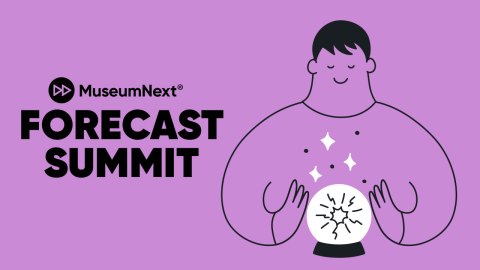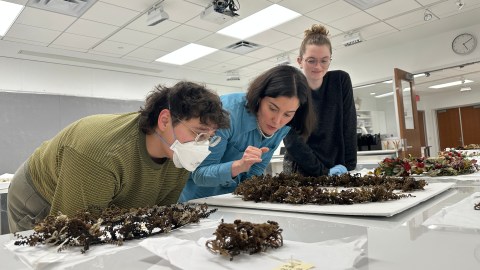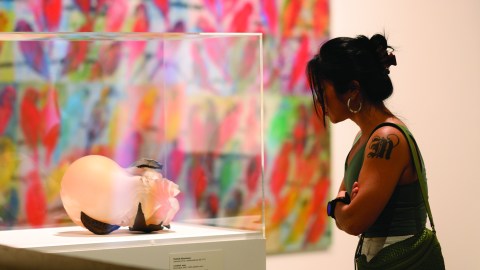
The Natural History Museum of Los Angeles County collaborated with artists—and among departments—to highlight the value of its collections research.
This article originally appeared in Museum magazine’s May/June 2025 issue, a benefit of AAM membership.
Why do we collect? Curious visitors and museum skeptics alike ask this question—one that museums often struggle to answer. The Natural History Museum of Los Angeles County (NHM) houses over 35 million objects and specimens, most of which have never been, and will never be, on display. At NHM, communicating how natural history collections shape our understanding of the world is front of mind at all times.
Our labs and storage rooms are active spaces where dozens of staff from our Research & Collections (R&C) department study the collections and host visiting researchers. Their discoveries inform the development of many new exhibitions. However, few exhibitions have explicitly described this research, and no permanent galleries have explored the purpose of the collections themselves…until now.
In November 2024, NHM opened “Collective Knowledge from Our Changing World,” a permanent exhibition featuring 12 large-scale photographs of collections objects, an atmospheric video showing objects in motion, and label text with behind-the-scenes stories about the incredible research NHM conducts every day. Three teams worked together collaboratively to tell these stories: an Exhibitions team with an in-house developer, more than a dozen curators and collections specialists, and an external artist team. Over this year-long process, these groups—each with distinct visions for the exhibition—learned how to build trust, communicate effectively, and work toward consensus to answer the fundamental question: Why does NHM collect?
The Big Picture
“Collective Knowledge” debuted as part of a new wing of the museum, the NHM Commons. Initial plans for this community hub and welcome center included a café, a theater, and a series of small displays. Once construction of the wing started, museum staff began to consider turning the 3,000-square-foot theater lobby into gallery space. Located near the entrance, this space could house an exhibition that immediately introduced visitors to the museum. However, transforming the lobby into a gallery posed constraints—it would also be a gathering place for groups and a queuing area for theatergoers, making extensive casework impractical.
As part of the Commons initiative, NHM’s Exhibitions leadership had already been working with the nationally known creative team CutlerBremner to document the excavation, transportation, and display of a newly discovered dinosaur species. This partnership sparked the idea of featuring object photography in the newly coined “Theater Gallery.” We soon engaged CutlerBremner for “Collective Knowledge,” forming a project team that also included members from the museum’s R&C and Exhibitions departments.
Three Distinct Visions
The three teams that planned the exhibition had distinct—and sometimes competing—visions and priorities.
Artists: The CutlerBremner team, led by Photographer and Director Craig Cutler and Creative Director Scott Bremner, had a strong background in still-life photography and film. Their initial artistic vision emphasized the beauty of collections objects through dynamic and unexpected photographs in the gallery. Drawing inspiration from pop art, they proposed large-scale images, vibrant and colorful backgrounds, dramatic lighting, and artful cropping. Early concept art included the tail of a dinosaur framed as a piece of sculpture and a bird’s egg spinning like a planet. Images like these would draw in visitors without immediately revealing their true nature. The ultimate goal was to create a fun, powerful, and modern representation of the museum.
Research & Collections: The R&C team saw the exhibition as an opportunity to share NHM’s research mission and explain why it maintains extensive scientific and cultural collections. Early conversations also raised the need to include answers to frequently asked visitor questions about where our collections come from and how we acquire them.
NHM collects in the major topical areas of zoology, paleontology, geology, history, and anthropology, with 18 discrete collecting departments—from dinosaurs and fishes, to minerals and mollusks, to archives and archaeology. Staff from across these many departments hoped to convey the breadth and significance of NHM’s collections, and the many kinds of research in which they are routinely used.
Exhibitions: As Exhibition Developer on the project, my primary goal was to unify the artistic and research-driven visions into a compelling narrative that would ideally guide both object selection and label text development. The Exhibitions team also wanted the gallery design to cohere with the rest of the museum and the label text to be welcoming, accessible, and accurate.


Meeting Challenges Together
As we worked together to align our visions, we negotiated several challenges: How could we distill such a large collection into a single, cohesive narrative? How could we balance the importance of both research and aesthetics when selecting objects? How could we appropriately contextualize each object while allowing room for artistic interpretation and messaging about larger collections themes?
Establishing and maintaining trust between our three teams was key. While we shared many goals and knew that the exhibition would feature images of objects from across our collections, the tight timeframe meant that we needed to select objects to photograph before we had developed a concrete exhibition narrative. We continued communicating and iterating as narrative development and object selection progressed concurrently.
Object Scouting
The first collections visits began just a week after the project’s official kickoff, before we had started any narrative development. R&C staff pulled objects and specimens from 11 collections, including anthropology, vertebrate and invertebrate zoology, mineral sciences, and paleontology. As the CutlerBremner team took reference images of objects that spoke to them visually, the Exhibitions team documented object information and any interesting stories the R&C staff shared. CutlerBremner soon developed concept sketches of how their favorite objects could be lit and cropped when photographed.
The Big Idea
Meanwhile, members of the Exhibitions and R&C teams worked on defining the exhibition’s core message—the Big Idea—which would anchor all content, from photographs to label text, to answer the question of why NHM collects. An early narrative concept involved highlighting specific research stories related to each object. However, based on their scouting visits, the CutlerBremner team had already begun planning photo concepts that included objects that had not been used in specific research.
Our challenge was to craft a broad statement that emphasized the importance of the collections research but could apply to any object the artist team photographed. This was less clear-cut than anticipated, but we were confident we could make it work—after all, every object in the museum is there for a reason, even if that reason does not involve an active research project. After many drafts, we finalized our Big Idea: “NHM’s collections form an archive of our rapidly changing world that we can explore together through science, history, and art.”


Photo (and Story) Selection
As the Big Idea was being refined, CutlerBremner photographed over 80 objects—largely of their own choosing—and shared 36 edited images with the Exhibitions and R&C teams. The next challenge was narrowing them down to 12 to include in the gallery. While all 36 photos hit the mark aesthetically, the objects’ labels would need to relate to the Big Idea—how each object had been, or could be, used to explore the world around us.
The Exhibitions team began by interviewing collections staff to gather information about each object. They had very little to say about some—these were quickly cut. They shared enough about other objects to fill a book. To narrow these down, the R&C team identified several high-level themes from our collections: salvage collecting, urban nature, biodiversity, conservation, deep time (geological or cosmic time), evolution, community collaboration, and new discoveries. We tried to identify at least one object from among the photos to illustrate each theme. When multiple objects addressed the same theme, we prioritized ones that would be difficult to display outside of photography due to how they are preserved (snakes in a jar of alcohol), their size (inch-long insects), or their sensitivity to light (brightly colored snail shells).
After piecing together this jigsaw puzzle of considerations, the Exhibitions and R&C teams settled on 12 object photos and presented them to the artist team. CutlerBremner then suggested swapping in several photos they felt strongly about including from an aesthetic perspective. While these photos had been cut because the objects did not have specific use stories, the labels for the objects allowed us to highlight broader collections themes such as preserving objects for future use and digital accessibility.
Label Text
Interpretive labels for “Collective Knowledge” followed museum-wide standards for length (about 50 words), reading level (6th–8th grade), and language (English and Spanish). After the photo selection process, we had a clear idea of how we would write about each photographed object in relation to the Big Idea and narrative themes.
During the review process, the R&C team requested additional context about where and when each object was created, collected, and acquired to highlight the importance of maintaining data-rich collections. To integrate this information without overwhelming visitors, we introduced a new format for the label tombstones that allowed us to include multiple types of dates and locations. We also added a graphic scale to each label so visitors could see the actual size of the objects, which appear monumental in the photographs.
In the end, “Collective Knowledge” did not follow an ideal exhibition process. A tight timeline required each team to begin its work before we had a shared vision for the exhibition. But in reality, few exhibitions follow an ideal process, which is aspirational and constantly changing.
What made this project successful was our commitment to collaboration. By building relationships across museum departments and with our external creative team, fostering open communication, meeting regularly to assess progress, and ensuring institutional buy-in, we navigated challenges together. We listened to each other’s concerns, remained flexible, and pivoted (several times) to forge common ground. The result is a visually stunning space that invites visitors to explore why NHM collects—and communicates the vital role museums play in the preservation and research of collections.
Tips for Building Consensus in Collaborative Exhibitions
Collaborations can be tricky, whether you’re working with colleagues in other departments or with external partners like artists or community members. Building trust through constant (and honest) communication is key. Here are a few more tips for successful collaboration.
Start collaborating early. Exhibition timelines are always tight. Scheduling time early to align goals and early concepts can help prevent time crunches later.
Focus on the big picture. A single exhibition can’t do or say everything. If you can’t make all your ideas fit, treat this exhibition as a first step and find ways to continue the story in future projects.
Turn challenges into opportunities. Collaborators won’t always agree. When you reach a sticking point, step back and reframe the challenge. Look for positive outcomes that will bring everyone back onboard.






